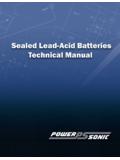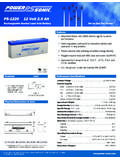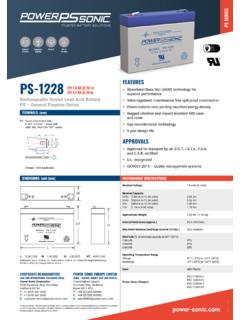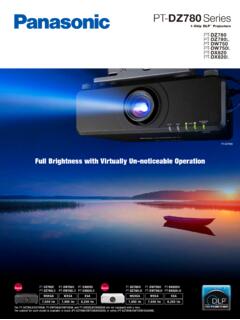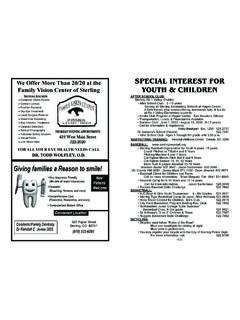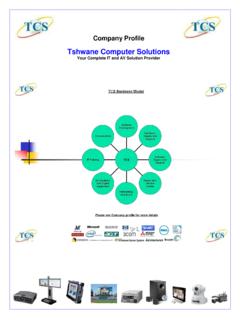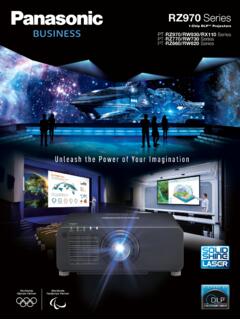Transcription of 1. IDENTIFICATION - Power-Sonic
1 Safety Data Sheet Issue Date: 01-Jan-2014 Revision Date: 01-May-2018 Version 1. 1. IDENTIFICATION . Product Identifier Product Name PS, PSH, PSG, PHR, PG, PDC and DCG Valve Regulated (VRLA) Batteries Absorbed Electrolyte (AGM). Other means of IDENTIFICATION SDS # POWER-001. Recommended use of the chemical and restrictions on use Recommended Use Battery Details of the supplier of the safety data sheet Manufacturer Address Power-Sonic Corporation 7550 Panasonic Way San Diego, CA 92154. Emergency Telephone Number Company Phone Number 1-619-661-2020. Emergency Telephone (24 hr) INFOTRAC 1-800-535-5053 (domestic), 1-352-323-3500 (International). 2. HAZARDS IDENTIFICATION . EMERGENCY OVERVIEW: This product is a nonspillable lead acid battery. The information below is intended for repeated and prolonged contact with the battery contents in an occupational setting.
2 In the absence of an incident or accident, is not likely to apply to normal product use. However, this Safety Data Sheet (SDS) contains valuable information critical to the safe handling and proper use of this product. This SDS should be retained and available for employees and other users of this product. Always be aware of the risk of fire, explosion, or burns. Do not short circuit the (+) and (-) terminals with any other metals. Do not disassemble or modify the battery. Do not solder a battery directly. Keep away from fire or open flame. Appearance Battery Physical State Solid containing liquid Odor Characteristic Classification This product is a battery. The classification below is based on the battery acid contained in the battery, which would only be released during an incident.
3 Acute toxicity - Oral Category 4. Acute toxicity - Inhalation (Dusts/Mists) Category 4. Skin corrosion/irritation Category 1 Sub-category B. Serious eye damage/eye irritation Category 1. Reproductive toxicity Category 1A. Specific target organ toxicity (repeated exposure) Category 2. Signal Word Danger _____. Page 1 / 10. POWER-001 - PS, PSH, PSG, PHR, PG, PDC and DCG Valve Revision Date: 01-May-2018. Regulated (VRLA) Batteries Absorbed Electrolyte (AGM). _____. Hazard Statements Harmful if swallowed Harmful if inhaled Causes severe skin burns and eye damage May damage fertility or the unborn child May cause damage to organs through prolonged or repeated exposure Precautionary Statements - Prevention Obtain special instructions before use Do not handle until all safety precautions have been read and understood Use personal protective equipment as required Wash face, hands and any exposed skin thoroughly after handling Do not eat, drink or smoke when using this product Use only outdoors or in a well-ventilated area Do not breathe dust/fume/gas/mist/vapors/spray Precautionary Statements - Response Immediately call a POISON CENTER or doctor/physician for all exposures IF IN EYES.
4 Rinse cautiously with water for several minutes. Remove contact lenses, if present and easy to do. Continue rinsing IF ON SKIN (or hair): Remove/Take off immediately all contaminated clothing. Rinse skin with water/shower Wash contaminated clothing before reuse IF INHALED: Remove victim to fresh air and keep at rest in a position comfortable for breathing IF SWALLOWED: Rinse mouth. Do NOT induce vomiting Precautionary Statements - Storage Store locked up Precautionary Statements - Disposal Dispose of contents/container to an approved waste disposal plant Other Hazards Very toxic to aquatic life with long lasting effects 3. COMPOSITION/INFORMATION ON INGREDIENTS. Chemical Name CAS No Weight-%. Lead 7439-92-1 65-75. Sulfuric Acid 7664-93-9 14-20. Tin 7440-31-5 <.
5 5. Calcium 7440-70-2 <.1. Fiberglass Separator Proprietary 5. Case material: Acrylonitrile Butadine Styrene (ABS) Proprietary 5-10. **If Chemical Name/CAS No is "proprietary" and/or Weight-% is listed as a range, the specific chemical identity and/or percentage of composition has been withheld as a trade secret.** Inorganic lead and electrolyte (sulfuric acid) are the main components of every Valve Regulated Lead Acid battery supplied by Power-Sonic Corporation. Other ingredients may be present dependent upon the specific battery type. For additional information contact Power-Sonic Corporation Technical Department. 4. FIRST-AID MEASURES. First Aid Measures _____. Page 2 / 10. POWER-001 - PS, PSH, PSG, PHR, PG, PDC and DCG Valve Revision Date: 01-May-2018.
6 Regulated (VRLA) Batteries Absorbed Electrolyte (AGM). _____. General Advice Immediately call a poison center or doctor/physician. Provide this SDS to medical personnel for treatment. Eye Contact IF IN EYES: Rinse cautiously with water for several minutes. Remove contact lenses, if present and easy to do. Continue rinsing. Skin Contact IF ON SKIN (or hair): Remove/Take off immediately all contaminated clothing. Rinse skin with water/shower. Wash contaminated clothing before reuse. Inhalation IF INHALED: Remove victim to fresh air and keep at rest in a position comfortable for breathing. Ingestion IF SWALLOWED: Rinse mouth. Do NOT induce vomiting. Most important symptoms and effects Symptoms Harmful if swallowed. Harmful if inhaled. Causes severe skin burns and eye damage.
7 May damage fertility or the unborn child. May cause damage to organs through prolonged or repeated exposure. Indication of any immediate medical attention and special treatment needed Notes to Physician Treat symptomatically. 5. FIRE-FIGHTING MEASURES. Suitable Extinguishing Media Use extinguishing measures that are appropriate to local circumstances and the surrounding environment. Unsuitable Extinguishing Media Not determined. Specific Hazards Arising from the Chemical Not determined. Hazardous Combustion Products Sulfuric acid: Sulfur trioxide, carbon monoxide, sulfuric acid mist, sulfur dioxide, and hydrogen sulfide. Lead Compounds: High temperatures above the melting point are likely to produce toxic metal fume, vapor, or dust; contact with strong acid or base or presence of nascent hydrogen may generate highly toxic arsine gas.
8 Protective equipment and precautions for firefighters As in any fire, wear self-contained breathing apparatus pressure-demand, MSHA/NIOSH (approved or equivalent) and full protective gear. 6. ACCIDENTAL RELEASE MEASURES. Personal precautions, protective equipment and emergency procedures Personal Precautions Use personal protective equipment as required. Methods and material for containment and cleaning up Methods for Containment There is no release of material unless the case is damaged or battery is misused/overcharged. If release occurs stop flow of material, contain/absorb all spills with dry sand, earth, or vermiculite. Do not use combustible materials. Neutralize spilled material with soda ash, sodium bicarbonate, lime, etc. Wear acid-resistant clothing, boots, gloves, and face shield.
9 Dispose of as hazardous waste. Do not discharge acid to sewer. _____. Page 3 / 10. POWER-001 - PS, PSH, PSG, PHR, PG, PDC and DCG Valve Revision Date: 01-May-2018. Regulated (VRLA) Batteries Absorbed Electrolyte (AGM). _____. Methods for Clean-Up Spent Batteries - send to secondary lead smelter for recycling. Follow applicable federal, state and local regulations Neutralize as in preceding step. Collect neutralized material in sealed container and handle as hazardous waste as applicable. A copy of this SDS must be supplied to any scrap dealer or secondary lead smelter with the battery. 7. HANDLING AND STORAGE. Precautions for safe handling Advice on Safe Handling Handle in accordance with good industrial hygiene and safety practice. Obtain special instructions before use.
10 Do not handle until all safety precautions have been read and understood. Use personal protective equipment as required. Wash face, hands, and any exposed skin thoroughly after handling. Do not eat, drink or smoke when using this product. Use only outdoors or in a well-ventilated area. Do not breathe dust/fume/gas/mist/vapors/spray. Due to the battery's low internal resistance and high power density, high levels of short circuit current can be developed across the battery terminals. Do not rest tools or cables on the battery. Use insulated tools only. Follow all installation instructions and diagrams when installing or maintaining battery systems. Conditions for safe storage, including any incompatibilities Storage Conditions Store batteries in a cool, dry, well ventilated area that are separated from incompatible materials and any activities which may generate flames, sparks, or heat.
